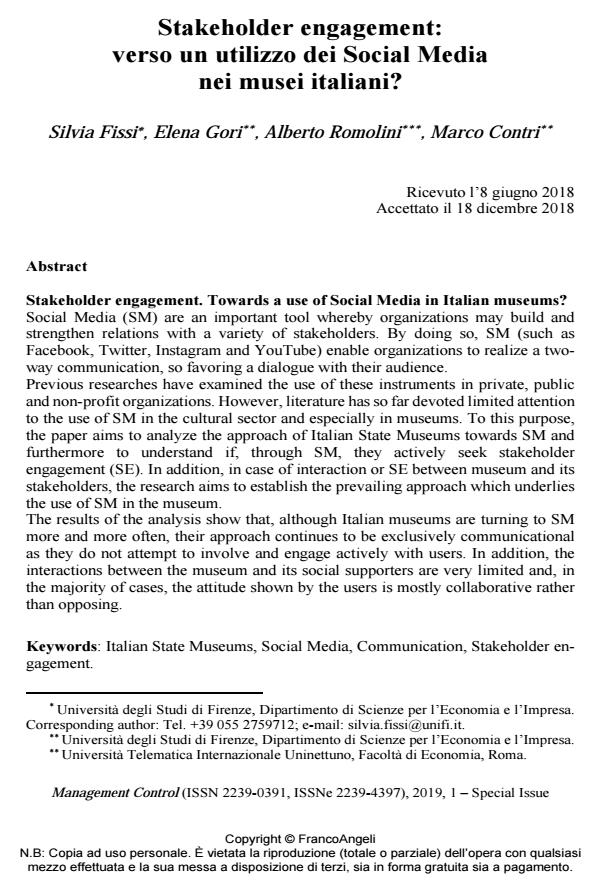Stakeholder engagement: verso un utilizzo dei Social Media nei musei italiani?
Titolo Rivista MANAGEMENT CONTROL
Autori/Curatori Silvia Fissi, Elena Gori, Alberto Romolini, Marco Contri
Anno di pubblicazione 2019 Fascicolo 2019/1 suppl.
Lingua Italiano Numero pagine 16 P. 145-160 Dimensione file 226 KB
DOI 10.3280/MACO2019-SU1008
Il DOI è il codice a barre della proprietà intellettuale: per saperne di più
clicca qui
Qui sotto puoi vedere in anteprima la prima pagina di questo articolo.
Se questo articolo ti interessa, lo puoi acquistare (e scaricare in formato pdf) seguendo le facili indicazioni per acquistare il download credit. Acquista Download Credits per scaricare questo Articolo in formato PDF

FrancoAngeli è membro della Publishers International Linking Association, Inc (PILA)associazione indipendente e non profit per facilitare (attraverso i servizi tecnologici implementati da CrossRef.org) l’accesso degli studiosi ai contenuti digitali nelle pubblicazioni professionali e scientifiche
Social Media (SM) are an important tool whereby organizations may build and strengthen relations with a variety of stakeholders. By doing so, SM (such as Facebook, Twitter, Instagram and YouTube) enable organizations to realize a two-way communication, so favoring a dialogue with their audience. Previous researches have examined the use of these instruments in private, public and non-profit organizations. However, literature has so far devoted limited attention to the use of SM in the cultural sector and especially in museums. To this purpose, the paper aims to analyze the approach of Italian State Museums towards SM and furthermore to understand if, through SM, they actively seek stakeholder engagement (SE). In addition, in case of interaction or SE between museum and its stakeholders, the research aims to establish the prevailing approach which underlies the use of SM in the museum. The results of the analysis show that, although Italian museums are turning to SM more and more often, their approach continues to be exclusively communicational as they do not attempt to involve and engage actively with users. In addition, the interactions between the museum and its social supporters are very limited and, in the majority of cases, the attitude shown by the users is mostly collaborative rather than opposing.
Parole chiave:Italian State Museums, Social Media, Communication, Stakeholder engagement
- Corporate accountability and stakeholder connectivity. A case study Eleonora Masiero, Daria Arkhipova, Maurizio Massaro, Carlo Bagnoli, in Meditari Accountancy Research /2020 pp.803
DOI: 10.1108/MEDAR-03-2019-0463 - Museum anchors and social media: possible nexus and future development Pasquale Ruggiero, Rosa Lombardi, Sarah Russo, in Current Issues in Tourism /2022 pp.3009
DOI: 10.1080/13683500.2021.1932768 - How do museums foster loyalty in tech-savvy visitors? The role of social media and digital experience Lamberto Zollo, Riccardo Rialti, Anna Marrucci, Cristiano Ciappei, in Current Issues in Tourism /2022 pp.2991
DOI: 10.1080/13683500.2021.1896487 - Social Media Analytics and Metrics for Improving Users Engagement Ioannis C. Drivas, Dimitrios Kouis, Daphne Kyriaki-Manessi, Fani Giannakopoulou, in Knowledge /2022 pp.225
DOI: 10.3390/knowledge2020014 - To adopt or not to adopt? A co-evolutionary framework and paradox of technology adoption by small museums Luna Leoni, Matteo Cristofaro, in Current Issues in Tourism /2022 pp.2969
DOI: 10.1080/13683500.2020.1870941
Silvia Fissi, Elena Gori, Alberto Romolini, Marco Contri, Stakeholder engagement: verso un utilizzo dei Social Media nei musei italiani? in "MANAGEMENT CONTROL" 1 suppl./2019, pp 145-160, DOI: 10.3280/MACO2019-SU1008